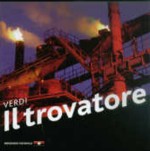I think I understand: The plot (or “punchline”) of Verdi’s Il trovatore rests on the fact that Azucena tossed the wrong baby on the fire lo those many years ago, so what could make more sense than setting the work in and around a fire-and-smoke-belching oil refinery? No, there has to be more: It’s really about the military-industrial complex and the have-nots who have lost out to those in power–refinery owner di Luna vs. the displaced Gypsies. That’s it.
Set on the vast floating stage on Lake Constanze at the Bregenz Festival, the huge, towering, bright-red chimneys, pipes, and multi-level staircases are guarded by machine-gun-wielding guards. The front of the stage is made up of the rubble from the refinery–discarded piping, oil barrels, and the like. Leonora happens on the scene in a chauffeur-driven Mercedes while ladies in evening gowns and gents in tuxedos have cocktails on the upper reaches of the refinery; her references to seeing a knight in armor at a tournament are utter nonsense under the circumstances. When the Gypsies arrive they remain on the outside of the fence; they clang on it for the Anvil Chorus. Di Luna enters the Convent Scene via speedboat; the lovers escape by the same means after the guerrilla Manrico and his men miraculously appear by rappelling their way down the smokestacks. At the opera’s finale, flames erupt everywhere. It’s very exciting, but the opera’s specific drama takes a back seat. It must have been a physical if not well-reasoned spectacle in person, and even on DVD it is a sight to behold. Just forget about 15th-century Spain.
This is about oil and it is set in the present; oil “enflames” (get it?) passions herein. I’ll quote Carsen from the accompanying booklet and be done with it: “There are more than one hundred references to fire in Cammerano’s libretto…The passions burn [the characters with] all their intensity…The petrochemical industry stands darkly as the destructive symbol of our times: it slowly burns itself out while the greed it fuels provides us with a constant reason for war.” And Paul Steinberg, discussing the immensity of the setting (there is room for 7,000 spectators) says in an interview, “Nobody in the audience has a bad seat.” His sets go perfectly with director Robert Carsen’s concept, and Miruna Boruzescu’s costumes, whether elegant for the upper classes or rag-tag/military for the others, are appropriate.
Since the opera’s actual drama takes a back seat to the allegorical concept, it is therefore up to the musicians to bring out the Verdian passions in the score, and some of them succeed. Iano Tamar’s Leonora is brilliant–deeply felt and handsomely sung despite occasional pitch problems. She sings a wonderfully expressive “Tacea la notte” aided by conductor Thomas Rösner’s generous, understanding rubato. She makes much of the text, caresses Verdi’s long lines, and lives the role, even as she wanders about a convent that looks like a factory.
Marianne Cornetti’s Azucena is a size too small but she acts and sings it with everything she has and makes us believe her. Carl Tanner’s large voice is reliable but one-colored; he cares for the text in a generic way but lacks an Italianate sense of either morbidezza or “ping”. He takes “Di quella pira” down a half-step and does little with the “Ah si, ben mio”. Furthermore, he is an awkward presence on stage (the only one in the show). Zeliko Lucic lives and breathes the Count di Luna and lacks only the suavity for “Il balen”. He’s suitably vicious as he shoots Manrico with his revolver at the opera’s close. Giovanni Battista Parodi is far too light as Ferrando.
The chorus is spectacular, the orchestra is just as fine, and Maestro Rösner leads as if he were actually paying attention to Verdi rather than what he is looking at on stage, which is a blessing. All other things being equal, when the first scene of the third act brought forth dozens of blue-costumed soldiers who, after the words “to the dance…”, began to kick-box to the rhythm of the ensuing chorus while dozens of flame bearers (at an oil refinery?) marched among them, I almost had to look away. And did I mention that when you consult the DVD’s menu, the motif is flames?
Picture, sound, and an interesting “Making of…” documentary are all excellent. The 1978 performance under Karajan on TDK (Kabaivanska, Domingo, Cossotto), though in inferior sound and picture, will make you happier, and even the ugly 1988 Met Opera production with a too-light, seemingly oblivious Pavarotti and a clumsy Eva Marton but terrific Zajick and Milnes will give you a better idea as to what Trovatore is all about.
































